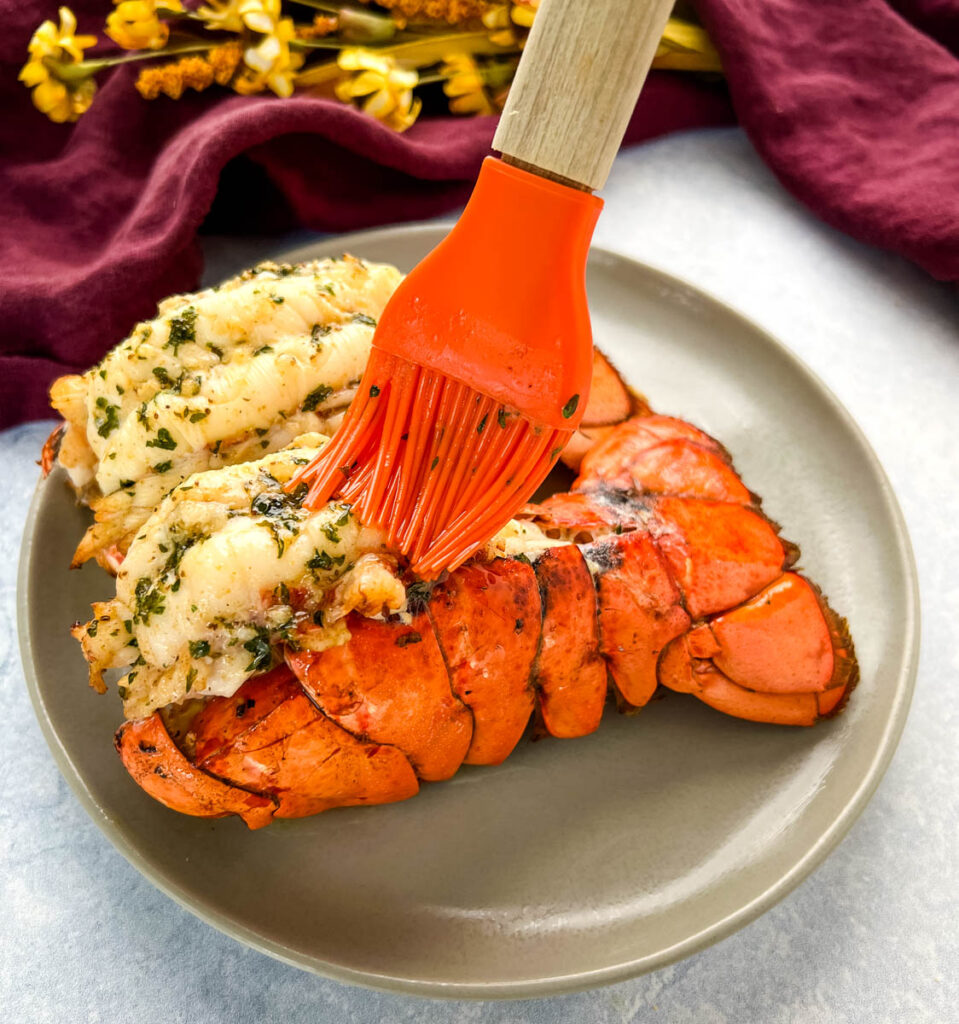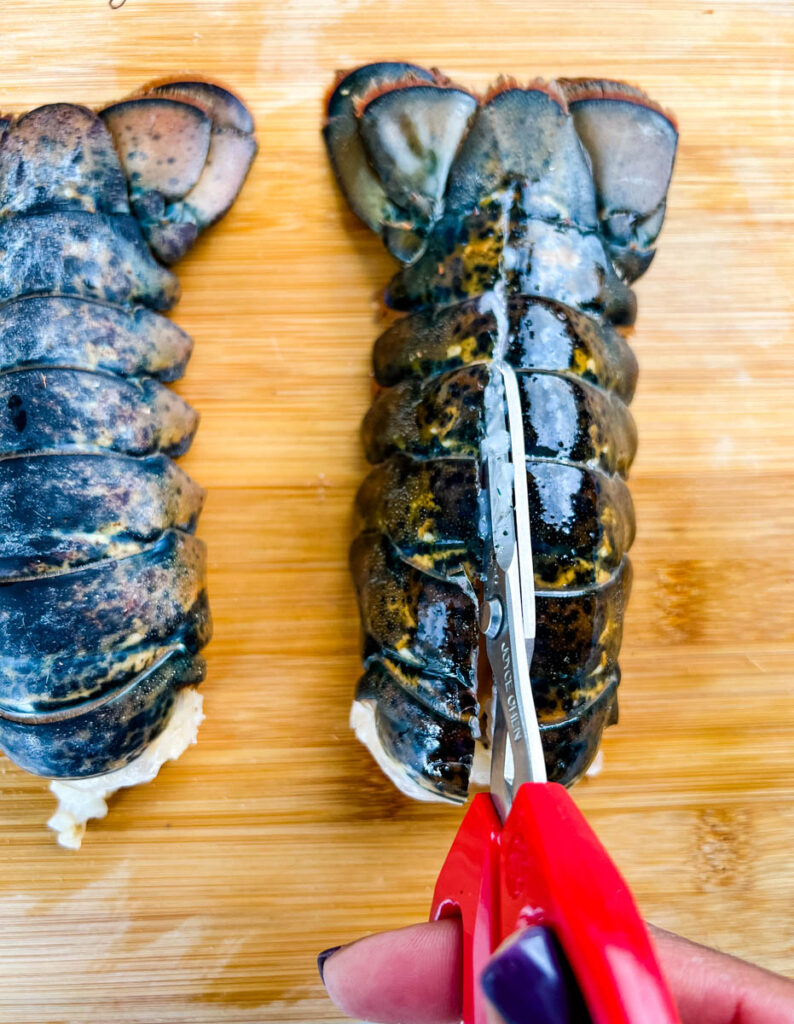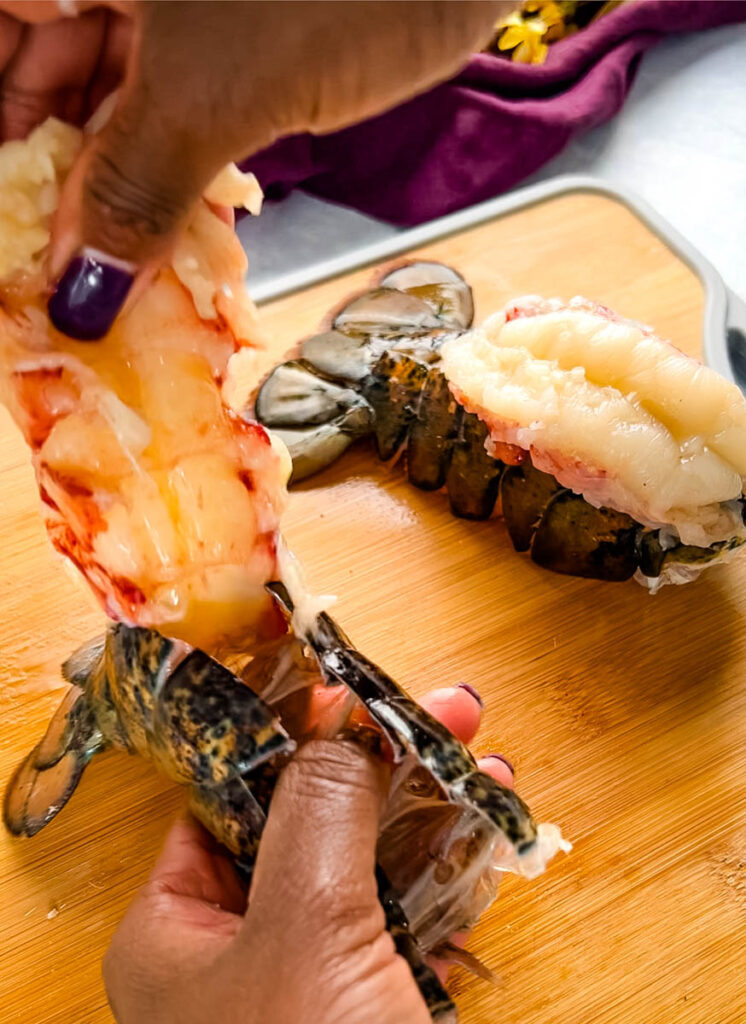This step-by-step tutorial and guide will show you how clean and prepare raw or frozen lobster tails. We include detailed instructions on how to cut, split, devein, and open the tails. Use this method to prep your favorite lobster meals and dishes.

Why You Should Clean Lobster Tails
Cleaning is important because it allows you to remove the meat from the shell, which makes it easier to cook and eat. Once you start cleaning, it’s easier to check if the lobster is fresh, because the meat should be firm and not discolored. You will also need to devein and remove the intestinal tract. It’s a thin, dark vein running down the center of the tail.
The intestinal tract contains the lobster’s digestive system, which includes the stomach and intestines. The stomach contains undigested food and digestive enzymes and the intestine contains waste material such as feces, bacteria, and other microorganisms that may cause food poisoning if consumed.
Removing the meat from the shell also allows you to add different seasonings or stuffings to the meat, which can enhance the flavor of the lobster. It also makes it easier to serve the lobster, as it can be cut into smaller pieces or presented in an attractive manner.
Cleaning these beforehand allows you to enjoy the lobster meat in the most flavorful and safe way.

What Type of Lobster to Buy
There are two main types of lobster tails available: cold water and warm water.
Cold-water lobster tails are typically considered to be of higher quality and have a sweeter, more delicate flavor. They come from the North Atlantic (often Maine) and are caught in colder waters. Coldwater lobsters are larger than warm-water and have more meat. Because they live in cold temperatures their meat gets a lot firmer than those from warm water, which will produce tender meat when properly cooked.
Warm water lobster tails are less expensive and have a slightly softer texture and milder flavor. They come from the Caribbean, South Africa, and Australia, and are caught in warmer waters. They are not as sweet and delicate as cold-water lobster tails.
Lobster tails are typically 6-8 oz in size.
If you are looking for a high-end meal or celebrating something special, cold water lobster tails may be the best option. If you are looking for something less expensive, then warm water will work.
How to Tell if It’s Fresh
The freshest lobster is one that has been caught, cooked, and served on the same day. When purchasing lobster this often isn’t the case so you definitely want to be diligent while purchasing.
Flash freezing is the process in which seafood is rapidly frozen at extremely low temperatures. This process locks in the flavor, texture, and nutrients and it allows them to be stored for long periods of time.
Flash freezing is a common practice in the seafood industry as it allows for the distribution of lobster to different locations around the world. Lobsters that are flash-frozen can be stored for up to 12 months and still maintain their quality.
Here are some things to take into consideration:
- Smell: It should have a fresh, slightly salty smell. It should not have a fishy or ammonia-like odor.
- Look and Appearance: The meat should be firm and white, not discolored or slimy. The shell should be hard and not cracked or broken.
- Touch: The tail should be flexible and not rubbery.
How to Thaw
Thaw in the fridge overnight. You can also place them in cold water for 30 minutes. They should not be thawed at room temperature to preserve the quality of the meat. When thawed properly, they can taste as good as fresh lobster tails.

Tools You Will Need
Kitchen shears or a sharp paring knife. It is best to use kitchen shears specifically designed for cutting seafood. These are usually made of stainless steel and are designed to be durable and rust-resistant. They have a sharp, serrated edge that easily cuts through the hard shells.
You will also want shears that are also equipped with a sturdy handle and finger guard, to help protect your fingers from the sharp edges of the shell. A good pair will have a hinge that allows the blades to be opened wide, which helps to get a better grip on the tail and make it easy to cut through the shell.
How to Clean and Prepare Lobster Tails
- Use kitchen shears or a sharp knife to make cut down the center of the top of the shell.
- Carefully remove the meat from the shell by gently pulling it out with your fingers.
- Once you have removed the meat, Remove the dark vein running down the center of the tail. This is the intestinal tract. Remove it with your fingers or with a knife.
- Rinse the lobster meat and shell under cold water and pat it completely dry.
- The lobster tail is now ready to be cooked or used in a recipe.
Check out our guide and tutorial on How to Butterfly Lobster Tails here.
Lobster Recipes
Smoked Lobster Tail
Lobster Pizza
Lobster Grilled Cheese
Air Fryer Lobster Tail
Lobster Tacos
Lobster Ravioli with Tomato Cream Sauce
More Guides and Tutorials
How to Cook Crab Legs
What is a Seafood Boil
What is Lump Crab Meat
What to Put on a Fish Sandwich
How to Tell if Salmon is Cooked

How to Clean and Prepare Lobster Tails
Equipment
Ingredients
- 2 lobster tails 6-8 ounces each is standard size.
Instructions
- Pat the lobster tails dry. Use kitchen shears or a sharp knife to make cut down the center of the top of the shell.
- Carefully remove the meat from the shell by gently pulling it out with your fingers.
- Once you have removed the meat, Remove the dark vein running down the center of the tail. This is the intestinal tract. Remove it with your fingers or with a knife.
- Rinse the lobster meat and shell under cold water and pat it completely dry.
- Grill: Grill at 400 degrees, medium-high heat for 8-12 minutes until the lobster reaches an internal temp of 130-145 degrees.Smoker: Smoke at 300 degrees until the lobster reaches an internal temp of 130-145 degrees.Bake: Bake for 8-12 minutes at 425 degrees until the lobster reaches an internal temp of 130-145 degrees.Air Fryer: Air fry for 5-8 minutes at 370 degrees until the lobster reaches an internal temp of 130-145 degrees.

QPbmCRVM
Wednesday 24th of September 2025
1
gate "oppna konto
Thursday 18th of September 2025
Your point of view caught my eye and was very interesting. Thanks. I have a question for you.
Index Home
Wednesday 2nd of July 2025
Thank you, your article surprised me, there is such an excellent point of view. Thank you for sharing, I learned a lot.
KfnqDuxw
Wednesday 14th of May 2025
1